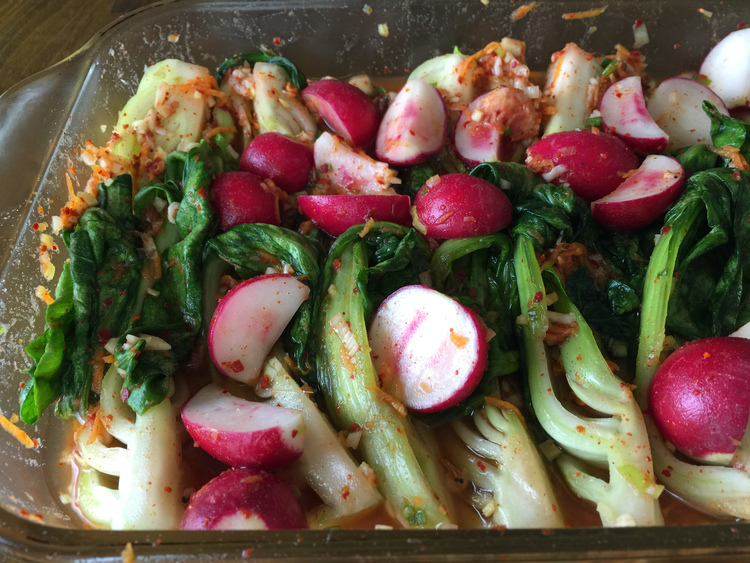Quick Bok Choy and Radish Kimchi
Adapated from K Food: Korean Home Cooking and Street Food by Da-Hae and Gareth West.
This is a quick kimchi that the authors call "fresh, light and summery – quite different from the typical cabbage kimchi." They suggest either eating it straightaway or letting it ferment for three or four days at room temperature; unfortunately, they neglected to provide instruction on how to do that, so I didn't; I just let it sit overnight in the fridge – and it was terrific.
You can use bok choy or baby bok choy. I used something in-between – sort of teenaged bok choy. If you use smaller babies, you might want to cut them in half rather than quarters. Sweet rice flour, gochugaru (Korean red chile powder/flakes) and saeujeot (tiny salted fermented shrimp) can be found in a well-stocked Asian market. Use regular gochugaru (not extra-hot), or one sold specifically for kimchi. Saeujeot is sold in plastic or glass jars in the refrigerated or frozen section. This kimchi is for eating straight rather than for cooking.
Ingredients
2 1/4 pounds bok choy, bottoms trimmed
9 ounces radishes (about 1 medium bunch)
1 tablespoon salt
1 tablespoon sugar
FOR THE KIMCHI "GLUE":
1 1/2 cups water
3 tablespoons sweet rice flour
3 tablespoons gochugaru (Korean red chile powder/flakes)
3 scallions, trimmed and finely chopped
1 1/2 carrots, peeled and grated
3 tablespoons saeujeot (salted fermented tiny shrimp)
1 1/2 tablespoons fish sauce
9 garlic cloves, minced
1 1/2-inch piece of ginger, peeled and minced
Instructions
1. Using a sharp knife, make a cut about 2 inches long to the base of each bok choy and use it to gently pull the bok choy in half (this helps to keep the leaves whole without shredding them). Repeat the process with each half so that the bok choy are quartered. Rinse the quarters and the radishes under cold running water. Drain, shaking off any excess water, and set aside.
2. To make the kimchi "glue," bring the water to a boil in a medium saucepan. Reduce the heat to low, sprinkle in the rice flour and whisk until there are no lumps. The mixture will be thick. Set aside to cool to room temperature.
3. While the glue is cooling, in a large mixing bowl, combine the salt and sugar. Add the bok choy quarters and rub the salt and sugar mixture between the leaves, ensuring the thicker parts near the base are well covered. Add the radish halves and mix everything together with your hands. Let stand for 30 minutes, tossing them together a couple times to make sure everything's brined.
4. Add the remaining "glue" ingredients to the glue base and mix together thoroughly.
5. When the bok choy and radishes are finished brining, thoroughly rinse them under cold running water, then shake them dry. Take a small handful of the glue. Rub it up and down each bok choy quarter to coat, again making sure that the thicker parts nearer the base are well covered. As each bok choy quarter is finished, fold the leaves toward the base to make a neat package and lay it in a glass baking dish (or whatever you have that will accommodate them in one layer). Fill in the gaps with the radish halves.
6. This kimchi can be eaten immediately, but it's even better if you cover it with plastic wrap and let it sit in the fridge overnight.

Quick Bok Choy and Radish Kimchi
Ingredients
- 2 1/4 pounds bok choy, bottoms trimmed
- 9 ounces radishes (about 1 medium bunch)
- 1 tablespoon salt
- 1 tablespoon sugar
- 1 1/2 cups water
- 3 tablespoons sweet rice flour
- 3 tablespoons gochugaru (Korean red chile powder/flakes)
- 3 scallions, trimmed and finely chopped
- 1 1/2 carrots, peeled and grated
- 3 tablespoons saeujeot (salted fermented tiny shrimp)
- 1 1/2 tablespoons fish sauce
- 9 garlic cloves, minced
- 1 1/2-inch piece of ginger, peeled and minced
Instructions
- Using a sharp knife, make a cut about 2 inches long to the base of each bok choy and use it to gently pull the bok choy in half (this helps to keep the leaves whole without shredding them). Repeat the process with each half so that the bok choy are quartered. Rinse the quarters and the radishes under cold running water. Drain, shaking off any excess water, and set aside.
- To make the kimchi "glue," bring the water to a boil in a medium saucepan. Reduce the heat to low, sprinkle in the rice flour and whisk until there are no lumps. The mixture will be thick. Set aside to cool to room temperature.
- While the glue is cooling, in a large mixing bowl, combine the salt and sugar. Add the bok choy quarters and rub the salt and sugar mixture between the leaves, ensuring the thicker parts near the base are well covered. Add the radish halves and mix everything together with your hands. Let stand for 30 minutes, tossing them together a couple times to make sure everything's brined.
- Add the remaining "glue" ingredients to the glue base and mix together thoroughly.
- When the bok choy and radishes are finished brining, thoroughly rinse them under cold running water, then shake them dry. Take a small handful of the glue. Rub it up and down each bok choy quarter to coat, again making sure that the thicker parts nearer the base are well covered. As each bok choy quarter is finished, fold the leaves toward the base to make a neat package and lay it in a glass baking dish (or whatever you have that will accommodate them in one layer). Fill in the gaps with the radish halves.
- This kimchi can be eaten immediately, but it's even better if you cover it with plastic wrap and let it sit in the fridge overnight.



